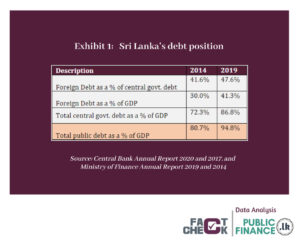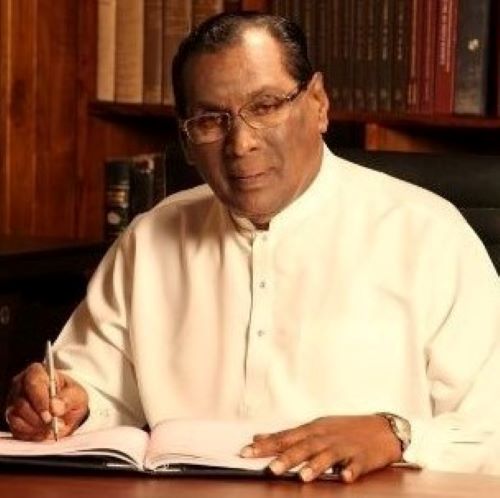Fact Check
The MP claims that Sri Lanka foreign debt increased from 72% to 96% in 2019 [24% point increase]. However, it is unclear whether the MP was referring to foreign debt as a percentage of GDP or total debt.
As reported by the Central Bank Annual report for 2020, as a percentage of GDP, foreign debt of the central government was 30% and 41.3% in 2014 and 2019, respectively. Alternatively, as a percentage of total central government debt, foreign debt was 41.6% and 47.6% in 2014 and 2019 (See Exhibit 1). Therefore, the numbers cited by the MP are hugely incorrect, on either interpretation of his statement.
If the MP had misspoken but meant total central government debt, instead of just foreign debt, one of his numbers would be closer to the mark. As a percentage of GDP, total central government debt was 72.3% and 86.8% in 2014 and 2019. If the MP had misspoken but instead meant total public debt (central government plus SOEs) then a different number of his would be closer to the mark. As a percentage of GDP, total public debt was 80.7% and 94.8% in 2014 and 2019 (See Exhibit 1).
In summary, the MP is completely incorrect in denoting his figures as foreign debt. If instead he had meant central government debt, then he is incorrect on the 2019 percentage, and if instead he meant public debt, then he is incorrect on the 2014 percentage. However generously this statement is read, the MP’s statement hugely exaggerates the increase in debt between 2014 to 2019.
Therefore, we classify his statement as FALSE.
**FactCheck.lk’s verdict is based on the most recent information that is publicly accessible. As with every fact check, if new information becomes available, FactCheck.lk will revisit the assessment.

Sources
Central Bank Annual Report 2020
Central Bank Annual Report 2017
Ministry of Finance Annual Report 2019
Ministry of Finance Annual Report 2014


